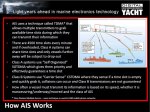Roberto
Well-known member
On my boat I have a combined VHF/AIS receiver, plus an AIS transponder.
The two are totally separate: two gps, two antennas, etc
The radio AIS RX flow is fed into a PC with Opencpn;, the transceiver works by itself, no cables to anything. The signal sent into the air by the transceiver is received by the VHF/AIS antenna, and fed into the PC.
This allows to see what kind of difference exists between my own AIS signal and my actual position.
After a number of days of close observation, I noticed that usually the 30s update time Class B use is more than enough for anti-collision purposes: other boats "see" myself through AIS in a position very near to the actual one.
The problem seems to come out when there is a lot of Class A traffic: in this case, I found differences can be of the order of 0.2-0.3 miles. By "differences" I mean the last position sent by my class B transponder and my actual position. In other words: when my AIS sends my position and speed vector they are of course identical to my actual one, but then they remain for minutes, often having no resemblance with what the boat did later.
Example 1, taken near Finisterre TSS, OpenCpn showed more than one page of AIS targets.
My actual position (red roundish icon), and the last available AIS position my TXR sent (green triangle); this means if others look at their AIS screen they see myself being and doing what the green triangle is doing, whereas I am in the "red" position with the red vector

Example 2
Approaching this port, the delay was such that I had rounded the breakwater and well inside the port and my last AIS position (possibly with a 2-3-4 minutes delay) was still showing my boat outside. Sorry I could not take the screenshot it was too busy.

Ok, AIS positions report their "age", professional shipping tend not to rely on AIS, etc etc but I am tempted to go "stealth" and not send out any ais message in these circumstances. (I have an RTE by the way).
What are your opinions ?
r
The two are totally separate: two gps, two antennas, etc
The radio AIS RX flow is fed into a PC with Opencpn;, the transceiver works by itself, no cables to anything. The signal sent into the air by the transceiver is received by the VHF/AIS antenna, and fed into the PC.
This allows to see what kind of difference exists between my own AIS signal and my actual position.
After a number of days of close observation, I noticed that usually the 30s update time Class B use is more than enough for anti-collision purposes: other boats "see" myself through AIS in a position very near to the actual one.
The problem seems to come out when there is a lot of Class A traffic: in this case, I found differences can be of the order of 0.2-0.3 miles. By "differences" I mean the last position sent by my class B transponder and my actual position. In other words: when my AIS sends my position and speed vector they are of course identical to my actual one, but then they remain for minutes, often having no resemblance with what the boat did later.
Example 1, taken near Finisterre TSS, OpenCpn showed more than one page of AIS targets.
My actual position (red roundish icon), and the last available AIS position my TXR sent (green triangle); this means if others look at their AIS screen they see myself being and doing what the green triangle is doing, whereas I am in the "red" position with the red vector

Example 2
Approaching this port, the delay was such that I had rounded the breakwater and well inside the port and my last AIS position (possibly with a 2-3-4 minutes delay) was still showing my boat outside. Sorry I could not take the screenshot it was too busy.

Ok, AIS positions report their "age", professional shipping tend not to rely on AIS, etc etc but I am tempted to go "stealth" and not send out any ais message in these circumstances. (I have an RTE by the way).
What are your opinions ?
r


